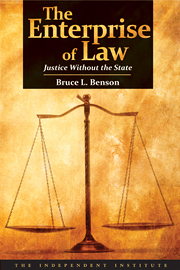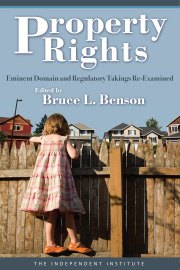It is widely recognized that central-government attempts to completely plan economies (that is, totally eliminate private property rights) are destined to fail. But even lower levels of government can have debilitating impacts on an economy by undermining private property rights through planning and regulation.
Indeed, as urban-policy analyst Sam Staley explains, the implications of the “socialist calculation debate” between Austrian economists Ludwig von Mises and F. A. Hayek and socialists Oskar Lange and Abba Lerner also apply to state and local development planning and land-use regulation. The planners’ knowledge deficiencies, however, are not the only reason that planning is destined to fail. Planning and regulation are inevitably destabilizing because the government’s rules continuously change in the face of a spiraling process of competition to influence the allocation of property “rights.” Consider an example.
The Oregon legislature created a new state agency in 1973, the Department of Land Conservation and Development, headed by the Land Conservation and Development Commission (LCDC). This department was vested with the power to establish statewide land-use policy and established 19 goals over a three-year period. However, H. Jeffrey Leonard points out that three goals intended to limit the geographic scope of growth have dominated: establishment of urban-growth boundaries, preservation of farm lands, and preservation of forest lands. All local governments were ordered to develop comprehensive land-use plans, to be approved by the LCDC, that implemented the statewide policy goals.
With this legislation, Oregon established itself as the leader in statewide land-use planning, serving as a model for other states that have followed. Arthur Nelson and James Duncan contend that “Oregon’s planning program is widely considered one of the most comprehensive and effective in the nation.” Presumably, planners in other states aspire to be just as effective. So an examination of Oregon’s record should provide a reasonably good prediction of what other states that have started down the planning path can expect. Just what has the effect been?
Edward Sullivan contends that land-use planning and regulations in Oregon resulted in “uniformity and relative predictability in land-use decision making.” But in reality, as David Hunnicutt points out, “[D]efenders of Oregon’s land-use planning system seem to forget that Senate Bill 100 (1973) [which set up a system of mandatory statewide planning], amended countless times over the years due to vagaries in the original language, has spawned endless litigation, and has resulted in the creation of two separate state agencies, costing taxpayers millions of dollars annually to staff and operate.” Consequently, as Steven Giesler, Leslie Marshall Lewallen, and Timothy Sandefur explain, “Oregon’s land-use regulation system had become a labyrinth of unreasonably restrictive regulations that made no allowances for the costs and burdens imposed on property owners.”
Regulation Is Destabilizing
The primary reason for the destabilizing impact of planning is that regulation to implement the plans involves the assignment of property “rights” and enforcement of those assignments. Property rights dictate the distribution of both material and nonmaterial wealth. Therefore, whenever regulation alters the assignment of property rights, some individuals lose; wealth is in fact taken.
One of thousands of examples from Oregon involves a 40-acre parcel of land zoned for forest use in Hood River County. When the owners purchased the land in 1983 for $33,000, the applicable land-use regulations allowed construction of a single-family dwelling. Following the purchase, Hood River County adopted new regulations to bring its comprehensive plan into compliance with statewide goals. Construction of a dwelling on the property was now prohibited. The owners submitted applications for a number of permits and changes (land-use permit, condition-use permit, zoning and comprehensive-plan changes) to allow them to build the home they had planned. In support of their application the owners provided a report from a forestry expert estimating that the value of the 40 acres without the ability to build a home was $691. The county’s forester countered that there was $10,000 worth of timber on the property. The owners filed suit against the county, challenging the regulation as a takings. The Oregon Supreme Court ruled for the county because the regulation did not result in loss of all economic benefits from using the property. In particular, the court noted that the ability to generate $10,000 in revenues from the timber on the land “certainly constitutes some substantial beneficial use.” The implication is that if the regulation allows some beneficial use of the land, the owner has not been deprived of his property.
Facing that kind of loss, landowners have incentives to protect their assets through litigation, lobbying, regulatory avoidance efforts, and so on. As a result, the planning and regulatory process is tremendously costly, but not just in terms of government expenditures. Some of the most significant costs are the resources diverted into a never-ending competition to avoid and/or alter the plans and regulations, competition that plays out in markets, legislatures, elections, bureaucracies, and courts. Many of the most significant costs are not even measurable. For instance, as regulators, courts, legislators, and voters react to the pressure arising from the competitive process, rules change. The uncertainty that characterizes a constantly changing regulatory environment shortens time horizons, altering investment and resource-use decisions in ways that reduce the long-run productive potential of resources.
Consider a few examples from Oregon’s tumultuous regulatory history. The state’s urban-growth boundaries were supposed to encompass enough land so that residential, industrial, commercial, and recreational needs could be met for 20 years, and the boundaries were to be flexible to accommodate changing conditions. Randal O’Toole explains, however, that once the urban service area boundaries were put in place, this “created a constituency for not moving them. People who lived near the boundary enjoyed scenic vistas and open space just a short distance away. Urbanites who lived on rural residential lands just outside the boundary enjoyed knowing that their neighbors would not be allowed to subdivide their land.”
By the late 1980s urban boundaries were becoming binding, particularly in the western part of the Portland area (Beaverton, Tualatin, Hillsboro), and land prices within the boundary “started rising at double digit rates,” according to O’Toole. One of Oregon’s strongest interest groups, 1000 Friends of Oregon, represented the constituency demanding fixed boundaries. O’Toole writes, “[I]nspired by the need to protect the boundary, 1000 Friends conceived and developed an entirely new view of growth management. Instead of moving the boundary to accommodate growth, vacant lands and existing neighborhoods inside the boundary should be built and rebuilt to much higher densities.”
In 1992 the regional government, Metro, was given substantial new powers to coordinate planning for the 24 cities and three counties in the Portland area, and within a few months, this government published a draft plan to implement the 1000 Friends urban-growth policies. Metro applied new minimum-density zoning ordinances to existing neighborhoods to prevent construction of single-family homes on lots zoned for higher density. (For instance, an owner of a lot zoned for up to, say, 24-units-per-acre apartments, is not allowed to build a single-family home, or even a duplex; instead, perhaps a minimum six-units-per-acre complex might be allowed.) While some single-family units continued to be allowed, they were restricted to very small lots. O’Toole gives an example of a development in Orenco, where single-family homes do not have backyards and each homeowner has only a ten-foot-wide side yard on one side of the house. (The ten-foot side yard on the other side belongs to the neighboring homeowner.)
As a result of the binding growth-management boundaries and regulatory limits on construction of new single-family units, Portland has turned from one of the nation’s most affordable markets for single-family housing in 1989 to one of the least affordable since 1996. The cost of an acre of land for housing rose from $20,000 in 1990 to $200,000 in 2006. Clearly, those who own any land that is still available for development are reaping huge benefits. Similarly, anyone who owns a previously constructed single-family home, particularly on a reasonably large lot (and especially if it is near the urban-growth boundary) has seen a dramatic increase in wealth. On the other hand, O’Toole notes, the National Association of Homebuilders reported that while more than two-thirds of Portland households could afford to buy a median priced house in 1989, only about 30 percent could afford such a home in 2006. Metro planners’ “response to the lack of affordable housing has been the implementation of more regulation” by mandating that developers provide some “affordable housing” units in each new development.
Effects of Planning on Small Business
Changes in land values due to restrictions are the most obvious examples of transfers arising from Oregon’s land-use planning process, but there are many others. For instance, James Huffman and Elizabeth Howard explain that land-use regulation has significant negative effects on small and emerging businesses, thereby creating competitive advantages for, and even entry barriers to protect, large established businesses. After all, given the extensive zoning that exists in Oregon, individuals who want to start or expand businesses generally will “need to request variances, conditional use permits, and comprehensive plan amendments to develop such land. Any one of these application processes will cost the applicant significant preparation and legal fees with no guarantee of ultimate success.” In an effort to reduce the probability of denial of their applications, individuals generally must hire lawyers and various kinds of experts. Huffman and Howard write:
While the costs can vary significantly from one case to another, most applicants will spend $5,000 to $20,000 to gain approval for a basic conditional use permit [permission to engage in a special use in a particular zone]. This estimate does not include fees which might be incurred for transportation engineers who add $5,000 to $10,000 or for wetland consultants or fish biologists who add around $5,000 each to the small business owner’s application costs. The cost estimate also does not include the expense of educating neighbors or the local government’s staff who oppose the small business owner’s application. Small business owners can expect to pay at least another $10,000 per objection. As these figures demonstrate, costs incurred to obtain permit approvals generally far exceed the statutorily-imposed processing fee. However, the most difficult issue concerning application fees is that the considerable discretion of land use officials and the difficulty of anticipating challenges from third parties make the ultimate cost of the application hard to anticipate with any degree of accuracy. The uncertain costs [sic] of permit applications causes them to be a significant budgetary challenge in the development of a business plan.
Furthermore, even if the applications are successful, anyone who feels aggrieved by a local government’s land-use decision can appeal it to the Land Use Board of Appeals (LUBA), and then to the Oregon Court of Appeals. Opposition “almost always occurs,” Huffman and Howard write, either due to objections from local planning officials or the “inevitable not-in-my-backyard objections of neighborhoods.”
The legislature reduced the LCDC’s duties and powers in 1979 by creating LUBA, a three-member board appointed by the governor with power to hear virtually all individual and county government appeals of local land-use decisions. Michael Blumm and Erik Grafe contend that the legislature hoped to “encourage consistent adjudication.” If precedents are being created so that local governments and individuals are increasingly able to predict how disputes are going to be resolved, however, it seems reasonable to expect that LUBA’s caseload would decline over time. Yet, Huffman and Howard observe that LUBA reviews between 150 and 200 cases each year.
In addition to the costs of simply getting permission to locate a new business or expand an existing business, state and local governments impose exactions on property owners, such as requirements that businesses dedicate property to some public use in exchange for permission to develop their business activities. Indeed, as Gieseler and coauthors observe, such exactions in exchange for permits actually allows local governments to avoid state law by using land-use regulation to obtain public use of private property without paying for it, rather than by “purchase, agreement, or legislative authorization of eminent domain,” as the law requires. Exactions also can involve monetary payments in lieu of property dedications.
All businesses in Oregon, large or small, face similar costs of entry or expansion, of course (and therefore, economic growth is clearly reduced), but these costs still have distributional impacts. Huffman and Howard write, a “large developer or other business has the benefit of experience as well as the economies inherent in recurrent regulatory compliance. This is not to say that the costs of regulation are not significant for large businesses, only that they are likely to be even more significant for small businesses.” Furthermore, most of the compliance costs occur up front, before a new location or expansion is created. For large businesses, these costs are smaller portions of the total cost of the enterprise. Thus “large companies are often advocates for regulation, presumably because of both their competitive advantage [under regulation] relative to small business and because of public relations benefits associated with a perception of corporate responsibility.”
The costs limit entry by or expansion of small businesses, and therefore reduce the level of competition that existing businesses, large or small, expect to face.
Not surprisingly, if individuals subject to the negative consequences of planning and regulation, such as small businesses or individuals who want to build or live in single-family homes, can find a way to avoid those consequences, they have strong incentives to do so. Therefore, a political backlash against the comprehensive planning process materialized very early, and virtually every legislative session has amended the land-use planning statute. The legislature was not willing to make the major changes that opposition groups demanded, so they also focused on litigation and ballot referenda. Three different ballot initiatives designed to roll back land-use planning failed, however.
Even as these statewide efforts were failing, ad hoc organizations were springing up in many counties to oppose local planning efforts. Local officials in a number of counties who supported land-use planning faced recall campaigns, and a substantial number lost their jobs. These ad hoc groups were successful in bringing the planning process to a standstill in some counties for several months. The situation was ripe for a well-organized statewide interest group to take up the cause, and Oregonians in Action filled this niche.
Oregonians in Action was a primary actor in getting two reform measures on the 1998 ballot. One, which passed with 80 percent of the vote, required both state and local governments to mail notices to landowners describing any proposed changes in land-use regulations and laws. The second, a proposed amendment to the state constitution to allow citizens to petition to the state legislature for review of administrative rules, failed with 48 percent. These ballot measures were quickly followed in 2000 with an initiative to amend the takings clause in the Oregon Constitution to require state and local governments to compensate landowners for reduced property values arising from any law or regulation that restricts the owners’ use of their land. Opponents of the amendment, such as 1000 Friends of Oregon, estimated that passage would cost the state $5.4 billion a year. If this were true, of course, it would suggest that annual land-use planning was imposing huge losses on Oregon property owners. Over 54 percent of Oregon’s voters cast ballots in favor of this amendment, with majorities for approval in 30 of the state’s 36 counties.
Compensation is specified as the entire difference between the market value of the land before and after the regulation is applied, including the “net cost to the landowner of an affirmative obligation to protect, provide, or preserve wildlife habitat, natural areas, wetlands, ecosystems, scenery, open space, historical, archeological or cultural resources, or low income housing.” However, before the amendment could be implemented, opposition groups challenged its constitutionality. The Marion County Circuit Court declared the amendment unconstitutional in February 2001 in a summary judgment, concluding that it violated two clauses of the Oregon Constitution. The decision was appealed, but the court of appeals upheld the decision, and the State Supreme Court agreed.
Oregonians in Action did not give up after the court loss. The amendment was modified and reintroduced as an amendment to state statutes rather than the state Constitution. The result, Ballot Measure 37, went before Oregon voters in 2004. Supporters raised about $1.2 million, primarily through a political action committee, Family Farm Preservation PAC, as well as through Oregonians in Action. Opponents raised much more money, roughly $2.7 million, primarily through the No on 37 Take a Closer Look Committee. But even so, 61 percent of the voters approved the measure, with majorities in 35 of the 36 counties. Not surprisingly, supporters of land-use planning moved quickly against the measure, but their initial success was reversed by the state Supreme Court in 2006.
Lobbying and Litigation
While litigation was in progress, both sides were lobbying the state legislature. A large number of bills introduced in the 2005 legislature would have altered various aspects and implications of Measure 37. Most never left their committees, however, and none was enacted, perhaps because legislators hoped that the court would overturn the measure. The legislature did create a task force to evaluate the state’s land-use planning system as a whole. The ten-member force was ordered to provide an initial report to the 2007 legislature and a final report in 2009.
Before the 2007 legislature could take any action, roughly 7,560 Measure 37 claims were filed in Oregon (as of April 2007). Estimates of the monetary value of these claims range from $10.4 billion to over $19 billion, Blumm and Grafe report, and more than 750,000 acres of land were estimated to have been involved. The 2007 legislature faced considerable pressure to act on land-use regulation and/or amend Measure 37. The first action taken was to give government entities more time to adjudicate claims. Measure 37 had allowed 180 days, but the legislature extended this to 540 days for any claims filed after November 1, 2006. More important, the legislature also drafted a 21-page revision to Measure 37 to be referred to the voters in November 2007 as a ballot measure—Measure 49. The proposal to put the measure on the ballot passed both houses.
Both sides once again accumulated large amounts of money for the campaign to follow. Three PACs were established to oppose the measure: Fix Measure 49, Oregonians in Action PAC, and Stop Taking Our Property. Sarah Wetherson reports that almost $2.26 million was raised to campaign against the measure. Supporters raised about twice as much money, however, accumulating over $4.69 million. This time the pro-planning side won. Measure 49 was affirmed by 61 percent of the voters.
This massive ballot measure substantially altered several aspects of Measure 37. It retained the ability of landowners to make Measure 37 claims against land-use regulations that “restrict the residential use of private real property or a farming or forest practice and that reduce the fair market value of the property.” But it withdrew the ability to make such claims for regulations limiting commercial or industrial uses of land. It also imposed a variety of limits on residential use claims, essentially preventing waivers that would allow large residential developments.
Measure 49 brought a number of other important changes to Oregon land-use regulation, but as with previous legislation and ballot measures, it is likely that the new arrangements will not last. Given the tumultuous and ever-changing history of Oregon planning and land-use regulation, there surely is no reason to expect that interest groups like 1000 Friends of Oregon or Oregonians In Action will be satisfied with every aspect of the system produced by Measure 49. Court challenges are bound to arise. Lobbyists will be hard at work in future legislative sessions, attempting to revise the law in their favor, and ballot initiatives will provide a focus for more expensive political campaigns. Uncertainty about what property rights really are will persist as long as the planning process’ entrenched bureaucracies and easily manipulated politicians (and voters) facing interest-group pressures have the power to make and impose decisions on how property can be used.
Oregon is years ahead of many states in the development of statewide planning and in the evolution of organized opposition to the system. Are other states destined for similar instability and uncertainty? Judging from what has happened in other states that have pursued statewide planning, it seems likely. Arizona, California, Washington, and Idaho voters considered 2006 ballot measures similar to Measure 37. Arizona’s passed with almost 65 percent of the vote, while the other three failed, although California’s was close. (Gieseler and his coauthors note that legislation similar to Measure 37 also was under consideration in Montana, Texas, Wisconsin, and Washington.) Note that the fact that some of the ballot measures failed clearly does not mean that the issue is settled, as illustrated by the repeated efforts to restrict state regulatory takings in Oregon, many of which failed before Measures 7 and 37 passed.
Works Used
B. L. Benson, 1984, “Rent Seeking from a Property Rights Perspective,” Southern Economic Journal, 51: 388–400.
B. L. Benson, 2008, “Conclusion: Instability and Inefficiency are the Inevitable Results of Government Planning and Regulatory Implementation,” in M. C. Blumm and E. Grafe, 2007, “Exacting Libertarian Property: Oregon’s Measure 37 and its Implications,” Denver Law Review, 85: 2–90.
H. Demsetz, 1967, “Toward a Theory of Property Rights.” American Economic Review, 57: 347–359.
S. G. Gieseler, L. M. Lewallen, and T. Sandefur, 2006, “Measure 37: Paying People for What We Take,” Environmental Law 36: 79–104.
J. L. Huffman and E. Howard, 2001, “The Impact of Land Use Regulation on Small and Emerging Businesses,” Journal of Small and Emerging Business Law 5: 49–70.
D. J. Hunnicutt, 2006, “Oregon Land-Use Regulation and Ballot Measure 37: Newton’s Third Law at Work,” Environmental Law 36: 25–52.
G. Knaap and A. C. Nelson, 1992, The Regulated Landscape: Lessons on State Land Use Planning from Oregon, Cambridge, Mass.: Lincoln Institute of Land Policy.
H. J. Leonard, 1983, Managing Oregon’s Growth: The Politics of Development Planning, Washington, D.C.: The Conservation Foundation.
E. Mortenson, 2007, “Voters Keep Cigarette Tax as Is but Roll Back Property Rights,” The Oregonian (November 7).
A. C. Nelson and J. B. Duncan, 1995, Growth Management Principles & Practices, Chicago: Planners Press, American Planning Association.
R. O’Toole, 2001, “Exposé: 1000 Destroyers of Oregon,” Liberty Magazine (May 1): 25–30.
R. O’Toole, 2001, “The Folly of ‘Smart Growth,’ ” Regulation (Fall): 20–25.
S. R. Staley, 2007, “Takings for Economic Development: The Calculation Debate—Again,” Presented at the Southern Economic Association meetings, November 19, New Orleans.
E. J. Sullivan, 2006, “Year Zero: The Aftermath of Measure 37,” Environmental Law 36: 131–163.
S. E. Wetherson, 2007, “Measure Campaigns Near $22 Million Mark; Tobacco Money Accounts for Half; Timber Interests Contribute 61 Percent of Total to No on 49 Effort,” Democracy Reform Oregon, November 1: www.democracyreform.org.















